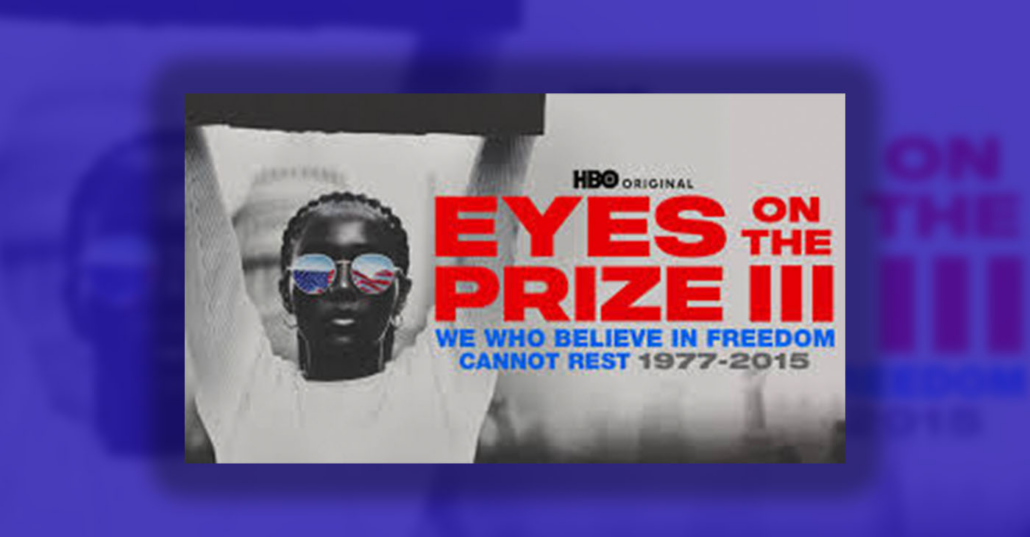By Stacy M. Brown
NNPA Newswire

HBO is set to debut Eyes on the Prize III: We Who Believe in Freedom Cannot Rest (1977-2015), the latest chapter of the groundbreaking documentary series that has long served as a definitive account of the fight for racial justice in America. The six-part series, executive produced by Dawn Porter, premieres Tuesday, February 25, with two episodes airing back-to-back on HBO. All six episodes will be available to stream on Max. Building on the foundation of Henry Hampton’s 1987 documentary Eyes on the Prize: America’s Civil Rights Movement, this new installment shifts the timeline beyond the traditional civil rights era, highlighting the continued struggle for justice from the late 1970s through 2015. The series captures pivotal moments in Black activism through archival footage and firsthand accounts, from grassroots battles over housing and healthcare to the rise of the Black Lives Matter movement.
Dr. Benjamin F. Chavis Jr., who appears in multiple episodes, played a key role in the history explored in the series. As a leader in the fight for racial equity, Dr. Chavis was the principal national organizer of the Million Man March in 1995 and the environmental justice movement in 1982 that challenged corporate and government negligence in Black communities. The series revisits both turning points, featuring voices from the front lines who fought for justice in the face of systemic resistance. The first episode, America, Don’t Look Away (1977-1988), explores community activism in New York’s South Bronx and Philadelphia. Local leaders took on fair housing and healthcare inequities during the final years of the Carter administration and the onset of Reaganomics. The episode includes former Bronx borough president Fernando Ferrer, public health officials, and activists who fought for Black communities amid the AIDS crisis.
As the series progresses, it turns to the criminal justice system’s impact on Black communities. Trapped (1989-1995) follows public defenders in Washington, D.C., and organizers in South Central Los Angeles who took on policies that disproportionately targeted Black residents. The documentary highlights the work of figures such as Congresswoman Maxine Waters and former U.S. attorney Robert Wilkins. The third episode focuses on one of the most defining moments of modern Black activism—the Million Man March. The 1995 gathering in Washington, D.C., on October 16, 1995, drew over one million Black men to assemble in the day-long gathering in a call for unity, responsibility, and community upliftment. Chavis, who was the National Director and a key organizer of the march, is featured alongside Rev. Al Sharpton, journalist Michael Cottman, and Professor Emerita Angela Davis. The episode details both the controversy and the lasting impact of the historic event.
Environmental justice takes center stage in the fourth installment, which examines the fight against industrial pollution and toxic waste in Black communities. Activists in North Carolina, West Virginia, and Florida battled corporations and government agencies that failed to protect Black neighborhoods from environmental hazards. Dr. Chavis, Deputy Executive Director of the Commission for Racial Justice of the United Church of Christ at the time, is featured along with Dr. Robert Bullard, widely regarded as one of the founders of the Environmental Justice Movement (EJM) along with Chavis, and former Vice President Al Gore. The final two episodes focus on legal and political battles over race in the late 20th and early 21st centuries. One installment looks at affirmative action and the shifting landscape of school desegregation, featuring UCLA law professor Kimberlé Crenshaw and civil rights leader Dr. William J. Barber II. The last episode explores the rise of the Black Lives Matter movement during the Obama years, as police killings of unarmed Black citizens galvanized a new generation of activists. It includes BLM co-founders Alicia Garza and Patrisse Cullors, as well as Rev. Al Sharpton.
The series arrives at a time when the fight for racial justice remains urgent, and the Black Press continues to document these struggles as it has been for nearly two centuries. Founded in 1827 with Freedom’s Journal, the Black Press of America was created to give Black communities a voice when mainstream media ignored or distorted their stories. That mission continues today through the National Newspaper Publishers Association (NNPA), representing over 230 Black-owned newspapers nationwide. Chavis, who leads the NNPA, has also co-authored a new book with NNPA Senior National Correspondent Stacy M. Brown. The Transatlantic Slave Trade: Overcoming the 500-Year Legacy is a deep examination of the lasting impact of one of history’s greatest atrocities. Covering the period from 1500 to 2024, the book details how the forced removal and brutal exploitation of millions of Africans laid the foundation for the systemic racism that persists today.
“The transatlantic slave trade isn’t just history—it is the root of the struggles we continue to face,” Chavis said. “To understand the present, we must confront the past.” Rock and Roll Hall of Famer and Public Enemy frontman Chuck D wrote the book’s foreword, recognizing its role in providing historical context for the challenges Black Americans still endure. With the release of Eyes on the Prize III and The Transatlantic Slave Trade, the importance of truth-telling remains clear. “For 198 years, the Black Press has ensured that our history is recorded accurately,” Chavis said. “We must continue to tell our own stories and ensure the truth is never erased.”

You must be logged in to post a comment Login